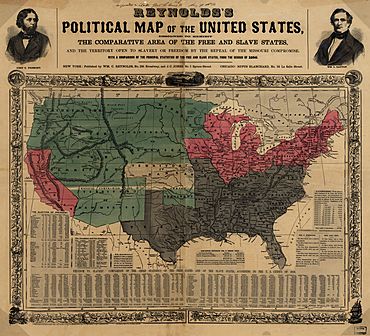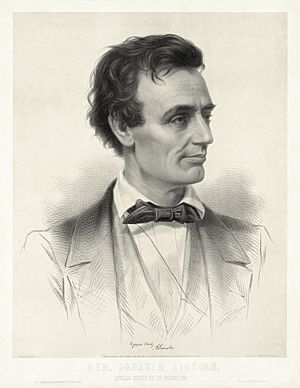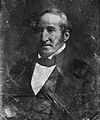Kansas–Nebraska Act facts for kids

The Kansas–Nebraska Act of 1854 created the territories of Kansas and Nebraska and was drafted by Democratic Senator Stephen A. Douglas of Illinois and President Franklin Pierce. The initial purpose of the Kansas–Nebraska Act was to open up thousands of new farms and make feasible a Midwestern Transcontinental Railroad.
It also allowed the states to vote on whether slavery was legal or not. This law cancelled the Missouri Compromise, which said that slavery was not legal in those areas. The Act was a key step on the way to the American Civil War.
Contents
Background
The availability of tens of millions of acres of fertile farmland in the area made it necessary to create a territorial infrastructure to allow settlement. Railroad interests were especially eager to start operations since they needed farmers as customers. Four previous attempts to pass legislation had failed. The solution was a bill proposed in January 1854 by Douglas — the Democratic Party leader in the US Senate, the chairman of the Committee on Territories, an avid promoter of railroads, an aspirant to the presidency, and a strong believer in popular sovereignty — the policy of letting the voters, almost exclusively white males, of a territory decide whether or not slavery should exist in it.
Results
The Kansas–Nebraska Act divided the nation and pointed it toward civil war. The Act itself virtually cancelled out the Missouri Compromise of 1820. The turmoil over the act split both the Democratic and Whig parties and gave rise to the Republican Party, which split the United States into two major political camps, the Republican North and the Democratic South.
Senator Stephen A. Douglas and former Illinois Representative Abraham Lincoln aired their disagreement over the Kansas–Nebraska Act in seven public speeches during September and October 1854. Lincoln gave his most comprehensive argument against slavery and the provisions of the act in Peoria, Illinois, on October 16, the Peoria Speech.
Lincoln's three-hour speech presented thorough moral, legal, and economic arguments against slavery and raised Lincoln's political profile for the first time. The speeches set the stage for the Lincoln-Douglas debates four years later, when Lincoln was running for Douglas's Senate seat.
A new anti-slavery state constitution, known as the Wyandotte Constitution, was eventually drawn up. On January 29, 1861, five weeks before Lincoln's inauguration, Kansas was admitted to the Union as a free state. On March 1, 1867, Nebraska was admitted to the Union. By then, the 1861–1865 Civil War had been fought, and slavery itself had been outlawed throughout the United States by the Thirteenth Amendment to the Constitution.
Images for kids
-
The United States after the Compromise of 1850 and the Gadsden Purchase. Douglas sought to organize parts of the area labeled as "Unorganized territory."
-
Forcing Slavery Down the Throat of a Freesoiler. An 1854 cartoon depicts a giant free soiler being held down by James Buchanan and Lewis Cass, standing on the Democratic platform of making slave states out of "Kansas," "Cuba," and "Central America". Franklin Pierce also holds down the giant's beard, as Stephen A. Douglas shoves a black man down his throat.
-
Sam Houston from Texas was one of the few southern opponents of the Kansas–Nebraska Act. In the debate, he urged, "Maintain the Missouri Compromise! Stir not up agitation! Give us peace!"
-
Thomas Hart Benton of Missouri – "What is the excuse for all this turmoil and mischief? We are told it is to keep the question of slavery out of Congress! Great God! It was out of Congress, completely, entirely, and forever out of Congress, unless Congress dragged it in by breaking down the sacred laws which settled it!"
-
Charles Sumner on Douglas – "Alas! too often those principles which give consistency, individuality, and form to the Northern character, which renders it staunch, strong, and seaworthy, which bind it together as with iron, are drawn out, one by one, like the bolts of the ill-fitted vessel, and from the miserable, loosened fragments is formed that human anomaly—a Northern man with Southern principles. Sir, no such man can speak for the North."
See also
 In Spanish: Ley de Kansas-Nebraska para niños
In Spanish: Ley de Kansas-Nebraska para niños










